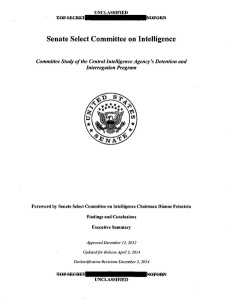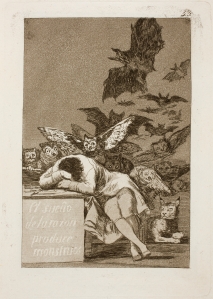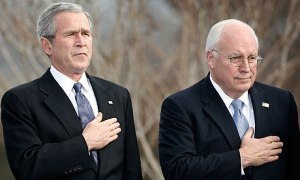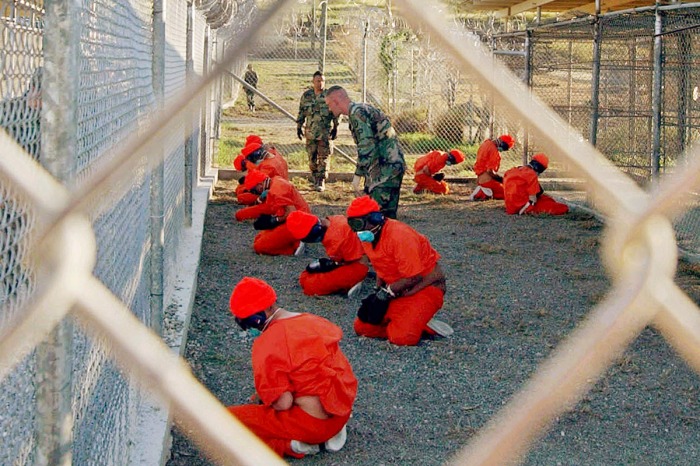Tuesday 23 December 2014
My administration has a job to do and we’re going to do it. We will rid the world of the evil-doers.
– George W. Bush, 16 September 2001
The United States is committed to the worldwide elimination of torture and we are leading this fight by example.
– George W. Bush, 26 June 2003
We do not torture.
– George W. Bush, 7 November 2005
It was out of the enhanced interrogation techniques that some of the leads came that ultimately produced the result when President Obama was able to send in Seal Team 6 to kill Bin Laden… They’ve been successful in part because of the capabilities we left them with, the intelligence we left them with, because of what we learned from men like Khaled Sheikh Mohammed back when he was subjected. I think it’s a mistake not to have an enhanced interrogation programme available now. I don’t know what they would do today if they captured the equivalent of Khaled Sheikh Mohammed.
– Dick Cheney, 9 September 2011
Some people called it [waterboarding] torture. It wasn’t torture… If I would have to do it all over again, I would. The results speak for themselves.
– Dick Cheney, 28 March 2014

I could go on. Examples of where the recently released Senate report contradicts a statement made by the former President George W. Bush or the former Vice-President Dick Cheney are not few in number. In the fight against the evil-doers the good employed evil tactics. The repugnant acts that the CIA did in the name of security are beyond belief. Here are just a few examples; the report details:
- an incident where the CIA’s Headquarters at Langley, Virginia refused to take action against an officer who tortured a prisoner to death because they ‘had been “motivated to extract any and all operation information” from the detainee.’ (page 14)
- at least 26 of the 119 known detainees ‘were wrongfully held and did not meet the detention standard… These included an “intellectually challenged” man whose CIA detention was used solely as leverage to get a family member to provide information’. (p. 12)
- rape was used as an instrument of torture: ‘CIA leadership… was also alerted to allegations that rectal exams were conducted with “excessive force” on two detainees’. (p. 100) ‘At least five CIA detainees were subjected to “rectal rehydration” or rectal feeding without documented medical necessity.’ (p. 4)
- at least three detainees had their families threatened, this included ‘threats to harm the children of a detainee, threats to sexually abuse the mother of a detainee, and a threat to “cut [a detainee’s] mother’s throat.”’ (p. 4)
- that if a detainee already had an injury, then it was used by the interrogators to their advantage: ‘two detainees that each had a broken foot were also subjected to walling, stress positions, and cramped confinement’. (p. 101)
The CIA authorised leaks about the enhanced interrogation program to the media, most notably The New York Times and Ron Kessler. In fact, Kessler’s 2003 book The CIA at War was assisted by the CIA’s Office of Public Affairs. These leaks are all the more shameful for including very favourable (now known to be false) statistics which indicated that the program was delivering results. As the report notes: ‘Kessler’s book stated that the FBI arrest of Iyman Faris was “[b]ased on information from the CIA’s interrogation of [KSM, Khalid Sheikh Mohammed],” and that the arrest of Khallad bin Attash was the “result” of CIA interrogations of KSM… These statements were incongruent with CIA records.’ (pp. 401-402)
It is illegal to leak information on secret operations. The OPA staff that ordered the leak will have kept their jobs, yet if Edward Snowden steps back into the country he will go straight to prison, just like Chelsea Manning. If the unauthorised leak benefits the CIA, nobody suffers, if it doesn’t, all hell breaks loose. That these leaks impeded the CIA’s own oversight committee is insane:
In several instances, CIA officers identified inaccuracies in CIA representations about the program and its effectiveness to the Office of Inspector General, the White House, the Department of Justice, the Congress, and the American public. The CIA nonetheless failed to take action to correct these representations, and allowed inaccurate information to remain as the CIA’s official position. (p. 15)

What is the point in a regulator if it cannot do its job? And, forgive me if I’m wrong, but didn’t the USA sign the United Nations Convention Against Torture in 1988? April 18th, to be precise? So should it not be the case that those people who ordered and carried out torture be prosecuted? If not, then what right does the USA have to demand any investigation or prosecution of torturers in the future? The US would not have a leg to stand on if an enemy were to use waterboarding, or walling, or stress positions against American prisoners.
I was going to leave it at that, but I got talking to a friend who defended the Agency’s program. His defence, which I feel I have to explain in full, went as follows: after 9/11 – after 2,996 people were killed – we had to do something. In those chaotic days following the attack we didn’t know what was happening. We didn’t know whether another attack was imminent. We had to make everyone feel safe again. Torturing people was necessary to reassure people that we had everything in hand. He told me how he was in London during the 7/7 attacks, and how everybody was frightened, how nobody knew what would explode next. People were paralysed with fear. He said he had been to Ground Zero and that he recalled looking at the names of all the people lost on that day and one entry stuck with him: a mother and an unnamed unborn baby. When people take the moral high ground, use hindsight, and make judgements on people who were in a difficult situation, it annoys him, he said. He kept saying that I would not understand why they did such things because I am in a relatively safe and stable environment. Torture would have provided some information, and that information will have saved lives. If there is another attack, he concluded, we will know that torture was not an effective measure of interrogation, but until then, it worked.
To the central thesis of my friend’s argument: yes, 2,996 people were horrifically killed. That does not mean that we abandon our principles to bring those responsible to justice. If something has to be built quickly, do we bring slavery back to get it done on time? No, that would be insane. He is correct in saying that we had to do something, and starting a war in Afghanistan to clear out the al-Qaeda sheltering Taliban was a good idea which ultimately struck at the route of the problem. More emphasis should have been placed on getting Pakistan onside, rather than extraordinary rendition and indefinite detention. Staying within the boundaries imposed by civil society is a must in a climate swamped with fear.

To the fear, the secondary point in his argument. I cannot say that I was not scared too. I was 12 in September 2001 and I was terrified. I was 15 when 7/7 happened, my Dad was in London, and I was frightened for his safety as I knew he sometimes took the Tube to work. The issue is that neither of us were policy makers. The intelligence community can be frightened, but must not act upon it. If they become hasty, then we all lose. What’s more, the enhanced interrogation program ran from 2001 to approximately 2008. We cannot place all of the 119 people who were detained over that period and their treatment down to the immediate post-9/11 fear. Torture is not justifiable. Ever. El sueño de la razón produce monstruos. The sleep of reason produces monsters. When one is petrified reason disappears, the hunt for a way to counteract the source of one’s fear becomes all encompassing and it is easy to slip into barbarism. Thus, one must be all the more alert.
Finally, the Torture Report says that no useful, credible or verifiable information was gained from torturing detainees. The information ascertained from torture did not stop the proverbial ticking bomb or prevent an attack. The report says that categorically (see p. 2). There is no way that it can be claimed – as Dick Cheney and Michael Hayden have repeatedly done since the release – that the program saved lives. It didn’t. We also know for certain that a lot of junk information was procured under torture and that at least two detainees were arrested and tortured on false information provided by another detainee undergoing torture. The program harmed more people – more innocent people – than it saved.
I think that the same thing scares both my friend and me: that we cannot claim to be the good guys anymore. If we are to learn anything from the colloquially known ‘Torture Report’ then it is that every side in the post-9/11 era did horrible things, things which belong on an episode of 24, not in real life. That is not a justification, it is a factual statement. For a long time I believed that the Nazis tortured, the USSR tortured, Saddam’s Iraq tortured, North Korea tortures – but (the collective Western) we do not torture. This report shows that ‘we’ do torture. We’re not as angelic as we think we are. The silver lining is that we can reform, although we’ve said similar things before. Remember the Pike Report?

If one allows torture, if one removes all limits to get at a morsel of information believed to exist in the detainees mind, then what will one not do?! If one is certain that it’s there then why not reach for the blowtorch or the power drill? That’s the logical insanity with which we’re dealing. If one can justify the use of waterboarding, then how can one not justify thumb screws? Accept one and then accept them all. Bring forth the Judas Cradle. This is the inhumanity of torture. That some people just don’t get it – including my friend, several ex-directors of Central Intelligence, and Dick Cheney – is another way of saying that the ends justify the means. Indeed, the slope is slippery.
Is there hope that we can take the moral high ground again? Yes, but it requires accountability. I won’t be holding my breath.
